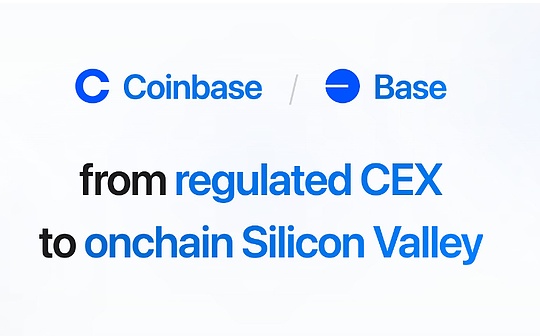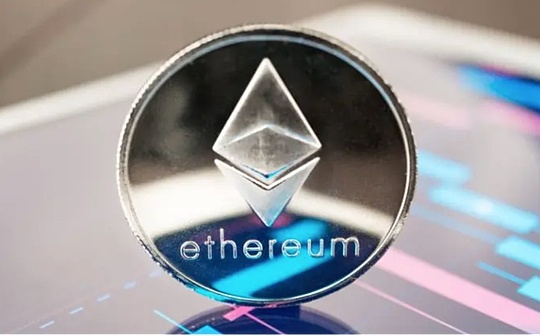
Source: Permadao
summary
At present, the mainstream decentralized storage platforms on the market include Arweave, Filecoin, and STORJ, which provides data storage methods that do not rely on a single center control point, and compare with traditional cloud storage services.Arweave focuses onLong -term or permanent storage, adopt a one -time payment model; Filecoin and STORJ establishes a blockchain -based storage market to provide flexible storage solutions.Arweave uses the “valid data mining” mechanism to motivate miners, while Filecoin is replicated by copy certificates and time and space certification to ensure data storage.Arweave’s storage practiceSimpleAnd Filecoin and Storj are for professional markets and traditional cloud storage users.The future development prospects of decentralized storage, especially in the decentralization of data, anti -review, and the application of AI.
Mainstream decentralization storage
At present, mainstream decentralization on the market is Arweave, Filecoin, and Storj.They have their own unique characteristics and design concepts:
-
ArweaveFocus on long -term or permanent data storage.
-
FilecoinProvide decentralized markets similar to traditional cloud storage and support flexible storage needs.
-
StorjFocus on decentralized cloud storage services that provide security and privacy protection.
These three platforms use blockchain technology, but their application scenarios, technology implementation and payment models are different. They are suitable for different types of storage requirements:
1. Arweave
-
Target:Provide a long -term and permanent data storage solution.Arweave’s goal is to store data until “forever”, which is mainly used for long -term data preservation.
-
technology:Using a unique blockchain technology called “blockweave”.Unlike traditional blockchains, the fabric contains a reference to the early random blocks in each new block, so that the design is designed to encourage the long -term preservation of data.
-
Payment model:Users can pay a one -time fee for data storage, and the data can be permanently accessed after the data is stored.
2. Filecoin
-
Target:It aims to create a decentralized storage market, similar to traditional cloud storage services.
-
technology:Filecoin is an incentive layer of IPFS (Internet file system).It uses “storage certification” and “time and space certification” to ensure the correct storage of data.
-
Payment model:The user pays the storage provider according to the amount and time of the storage data and time.This is a more traditional leasing model. Users can increase or reduce storage as needed and pay accordingly.
3. Storj
-
Target:Provide users with a decentralized cloud storage solution, focusing on security and privacy protection.
-
technology:STORJ uses encryption and sharding technology to protect data security and privacy.Before uploading, the client is encrypted and divided into multiple small pieces, and then distributed distributed on nodes globally.
-
Payment model:Storj’s payment model is similar to traditional cloud storage, based on the use of storage space and bandwidth.
In contrast, Arweave is unique, and the permanent storage that it emphasizes pays more attention to the anti -review and persistence of data.Both Filecoin and Storj use the storage market, focusing on the use of blockchain technology to reconstruct the storage market.
Business architecture analysis
The theoretical basis of Arweave permanently stored in data is similar to “Moore’s Law”.According to the statistics of data storage costs from 1980, storage costs decreased at a rate of 20% each year.According to this statistical law, the cost of data storage will converge into a constant after many years.Arweave forever is based on this and calculates the storage cost of 200 years of data.The user will pay the fee at one time when the data storage is stored.
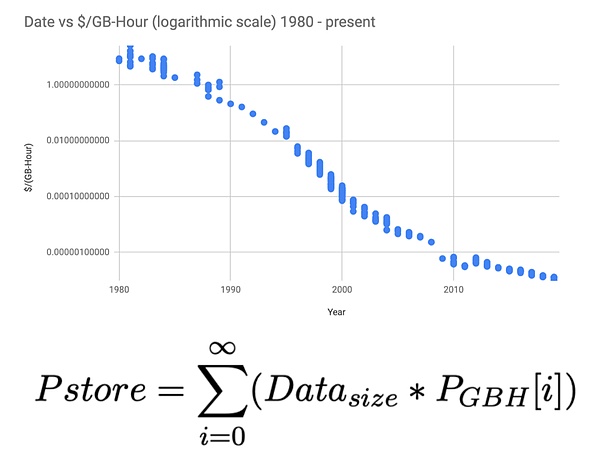
The so -called “effective data” refers to the data that has been stored in the Arweave network in the past, and users have paid the storage fee for 200 years for these effective data.Another character group in the network -miners, they use effective data to minify and provide effective data reading services.Different from other storage blockchain is that Arweave does not force miners to store data, but has established an incentive rule to encourage each miner to maximize the storage “effective data”.The more “valid data” stored in the Arweave network, the greater the “computing power” of mining.
Assuming that there are 100 TB valid data in the Arweave network, for miners, it is not necessary to choose to store all 100 TB data.In other words, the miners can minimate only 100 MB of data, but the computing power of the miner is very small.If the miners choose to store all the 100 TB data, his computing power will reach the maximum value.
In the “effective data mining” mechanism, Arweave network inspire miners to store the most data as much as possible, but does not force them to store all data storage.So is there the possibility of loss in the incentive mode?The following is a simulation calculation about data loss:

Filcoin and Storj both use blockchain technology to establish a data storage market.The main improvement of STORJ is data privacy.This article mainly explains the principle of Filecoin.
Similar to the traditional order book, users need to use Filcoin to go to the trading market for bidding orders, and indicate the time and number of backups of data storage. The mining union receives a profitable order.In order to ensure the fairness of the entire trading market, Filcoin has established a complex economic model and has set up multiple rules such as fines and small installment payment.Its core technology is to copy proof and time and space proof.
-
Copy certificate:Miners proved to users that data had been stored by dedicated physical equipment.Each miner proves the data of the user, the network will pay the miner.
-
Time and space proof:If there is only a copy of the copy, it will not guarantee that your data is always stored, and the miners can store the data only when submitting the certificate.For this reason, Filecoin supplemented the time and space proof that the purpose was to allow miners to continue to store these data.
To sum up, the basis and implementation scheme of Arweave will be:
-
The cost of forever decreases year by year
-
Miners are motivated through “effective data mining” to achieve forever data
Filcoin and STORJ are decentralized storage markets created by block technology. Their models are similar to the traditional trading market order book. Modern people provide demand and miners accept orders for data storage guarantee.Filcoin’s core technical point is: copy proof and time and space proof.
Storage practice
There are two ways to store data to Arweave.The first way is directly sent to the Arweave node and pays AR.The second method is to use ANS-104 (Bundled) data binding protocol to pack the data in batch to Arweave.
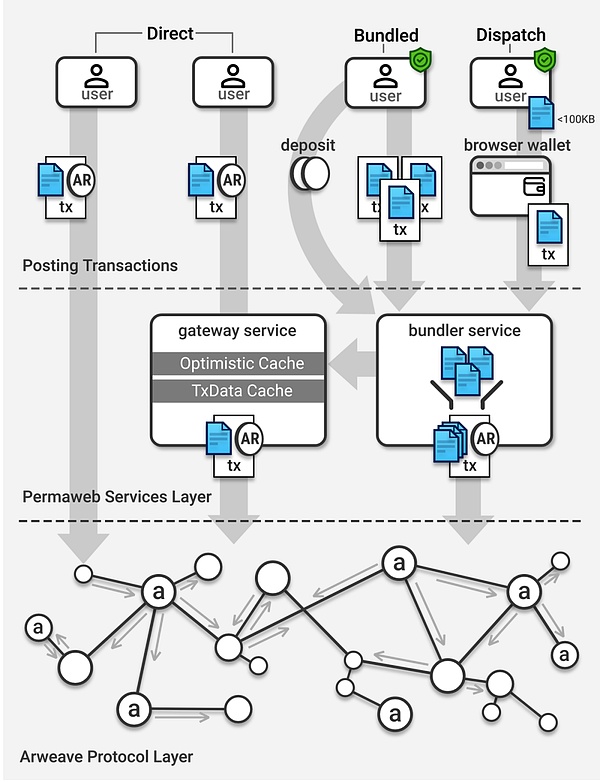
Directly store data to Arweave
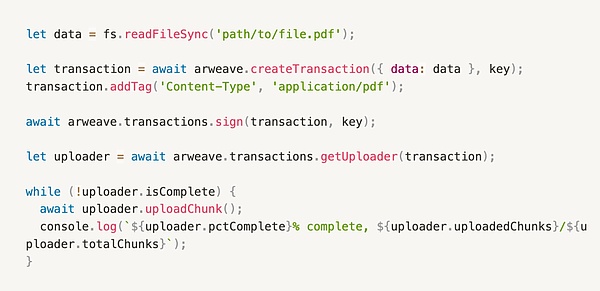
https://github.com/arweaveteam/arweave-js
Use ANS-104 to store data to Arweave (recommendation)
The block rate of the block of Arweave is low, usually about 2 minutes, and only 1,000 transactions can be processed in a block, which greatly limits the number of transactions stored in Arweave.Unlimited, users can directly store 100 MB or even 10 GB data directly to Arweave through a transaction.In order to solve the problem of expansion of the number of transactions, ANS-104 came into being.
ANS-104 is a binding technology for multiple transactions, which canTen tens of thousands of different data entities are bound to an ordinary Arweave transaction at one timeEssenceIt can be compared with Ethereum to Layer2 Rollup solution. The difference is that ANS-104 does not lose the security of the data. The binding data is also 100% complete data stored on Arweave.
Use ANS-104 Storage data code to demonstrate as follows:
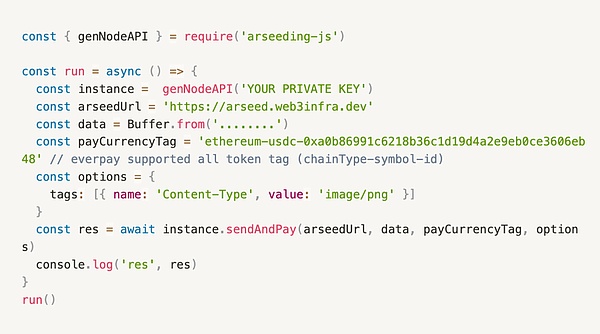
For more document reference:
https://web3infra.dev/docs/arseeding/guide/quickstart
Storage fee
The currently stored 1 GB data on Arweave is $ 7.5.
Reference for the latest storage expenses:https://ar-fees.arweave.dev/
Data from retrieval and download arweave
-
ArweaveNet gateway, indexes are the most complete.
Link: https://arweave.net/graphql
-
KNN3 gateway, real -time retrieval of ARSEEDING node data, fast speed.
Link: https://knn3-gateway.knn3.xyz/arseeding/graphql
Download Arweave data, you only need to know the Arid or Itemid of the data, code example:

Filcoin’s storage method
Storj storage method
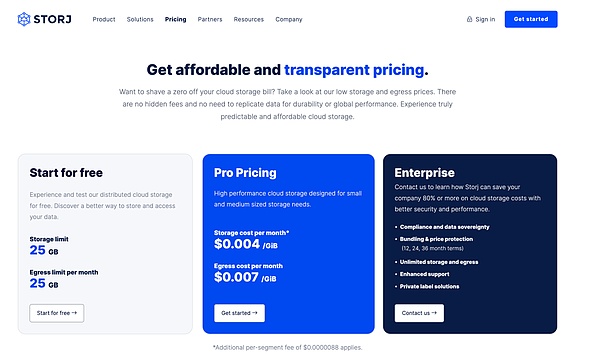
It is worth noting that arweave isThe native blockchain is stored. Once the data is sent to Arweave, it cannot be deleted and tampered withEssenceFilcoin and STORJ are lease models. The project party can stop storing leasing services at any time. The data in this mode does not have blockchain characteristics. The data characteristics and storage to centralized cloud services are consistent.
In order to more clearly distinguish between data storage of data storage such as Arweave and Filcoin, we can name the data on ArWEAVE “Consensus data“, Whether it is the data on the BTC or Ethereum, it is consensus data. These data have the characteristics that cannot be tampered with and traceable. The data stored by the FileCoin storage leasing market cannot be called consensus data.
Development prospect
Two completely different business lines appeared in decentralized storage.Among them, the business line represented by ArweaveTaking consensus data as the core, emphasize data decentralization, anti -review, traceability and other characteristicsEssenceThe business line represented by Filecoin is based on decentralized markets, emphasizing the successful distribution of storage resources and proved storage.The development of analog DEFI, the early IDEX used blockchain technology to create the order book market. The order book is a very traditional business model. It aims to use the mode of hanging orders to solve the ticket exchange.The outbreak of Defi is the liquidity mining technology brought by the Uniswap AMM trading model. AMM allows the order to fully automate the operation, realizing the combination of liquidity, and eventually ushered in the DEFI SUMMER explosion.In the current decentralized storage track, Filecoin represented by blockchain technology to create an order book market, and Arweave uses a unified model similar to AMM to manage data supply and demand.The arweave unified model is more convenient for data pricing and processing. Using Arweave can more conveniently complete the conversion of ordinary data to consensus data. The data above this consensus may usher in the “data combination” explosion.
At the same time, I have to mention the SCP theory (based on the consensus paradigm based on storage). The core idea is that as long as the data storage has consensus, the applications consisting of these data can also form consensus.The SCP emphasizes the calculation of the chain that the data can be stored on the chains such as BTC and Ethereum, and the data on the aggregate blockchain forms a unique state.Since these states have the same result in any computing unit, why do we still need to calculate it on the chain?Washing so many computing resources?
At present, the hot BRC20, Bitcoin inscriptions use the consensus calculated under the chain.The storage consensus emphasized by the BRC20 protocol and Arweave SCP is consistent. They all use the blockchain as the data layer to provide unable and traceable transaction data. The status calculation is completely under the chain.With Arweave’s storage capacity, the SCP theory can obtain a stronger consensus data set.The theory of Arweave SCP has developed a complete application solution -Permaweb, which is equivalent to the ultimate version of the Bitcoin indexer. Permaweb can not only handle the assets, but also process text, pictures and even videos.Imagine in the near future, super powerful indexes can be played by streaming media to create a completely decentralized vibrato.
At present, the application types supported by the PERMAWEB scheme are broadly used. Whether it is a network disk, content creation, and games, it can easily use the architecture for development.The data between PermaWeb applications can be combined with each other.For example, the writer uploads the created text and copyright to upload the creation of the creation through the content. In another game, the developer can directly quote the content of the writer and allow the player to pay the author to the author.
At present, DEPIN has the biggest dilemma is the performance of the blockchain. The DEPIN device will enter millions of households, but no blockchain can carry such a huge user interaction.Most DEPIN still uses a centralized way to process data, which will make DEPIN lose the characteristics of centralization.Consensus data can bring more powerful empowerment to DEPIN. Once the DEPIN data permanently, these data will also obtain a composite feature.For example, a green energy certificate can offset the energy consumption when the blockchain POW operation, can become a logo in content creation, or become a badge in the game.Data and value will flow everywhere.
Consensus data is also applicable to the field of artificial intelligence in AI.Human knowledge and history should be forever, and consensus data can ensure that AI cannot pollute and tampering with human knowledge and history.Similarly, consensus data can be used as the best data raw material for AI, so that AI can learn and process various effective information.






